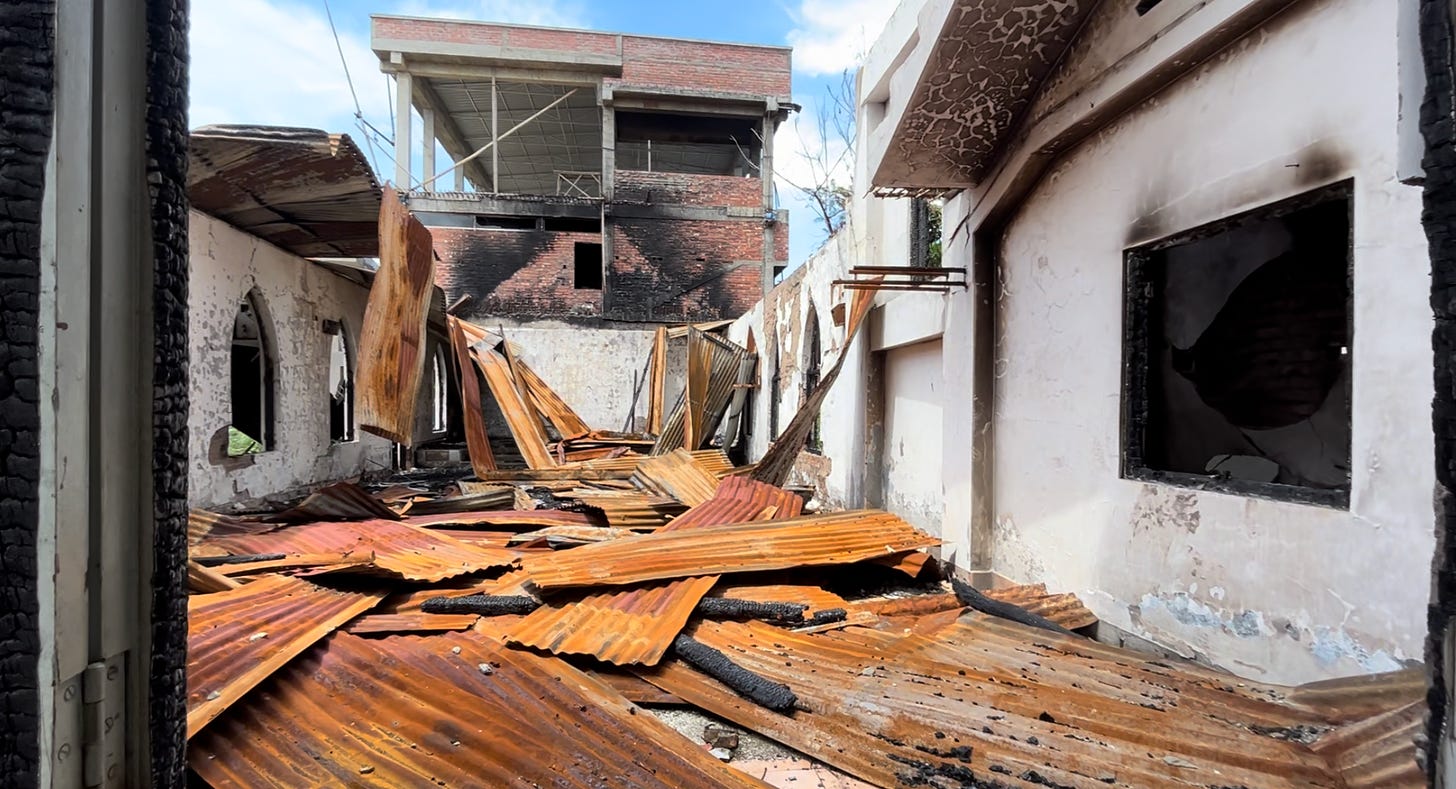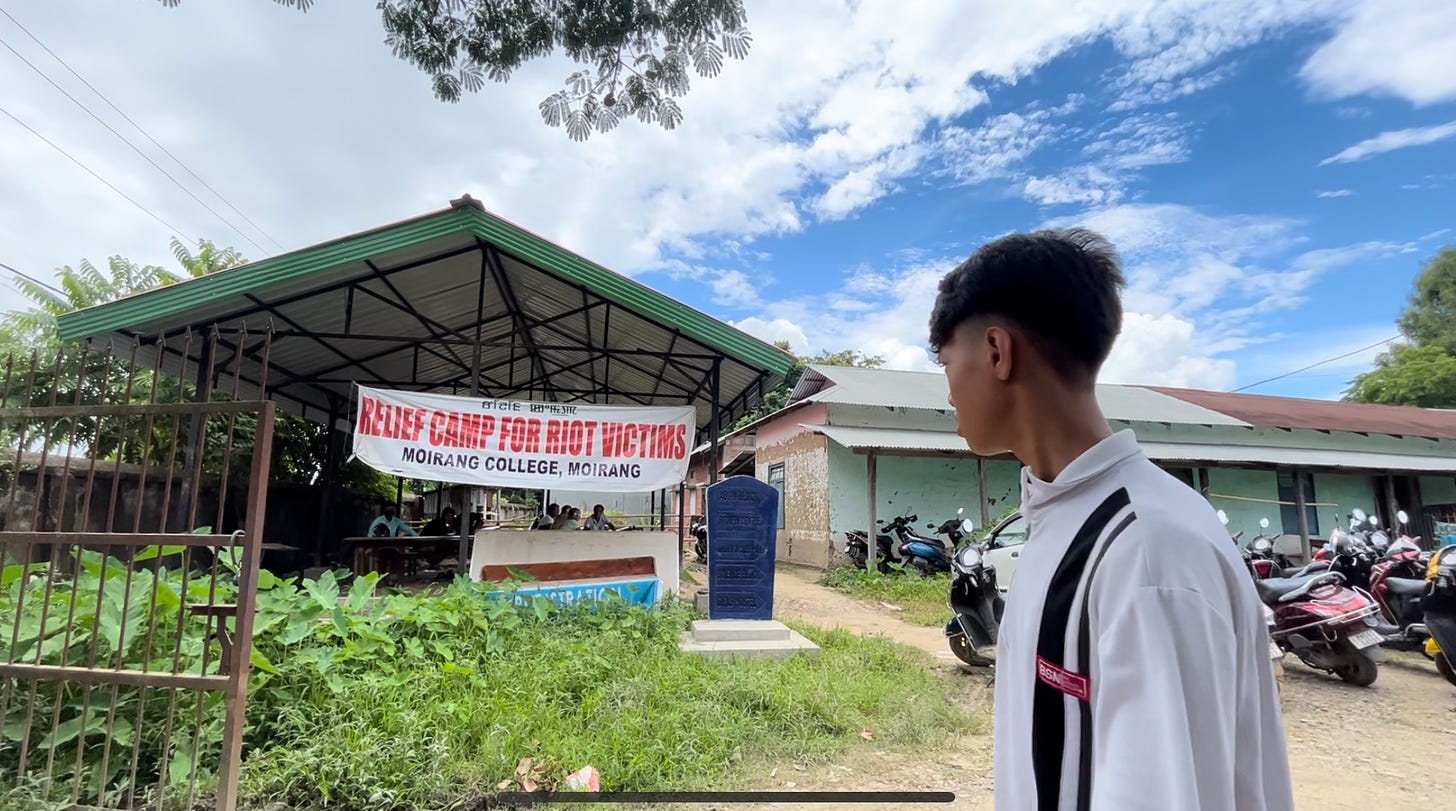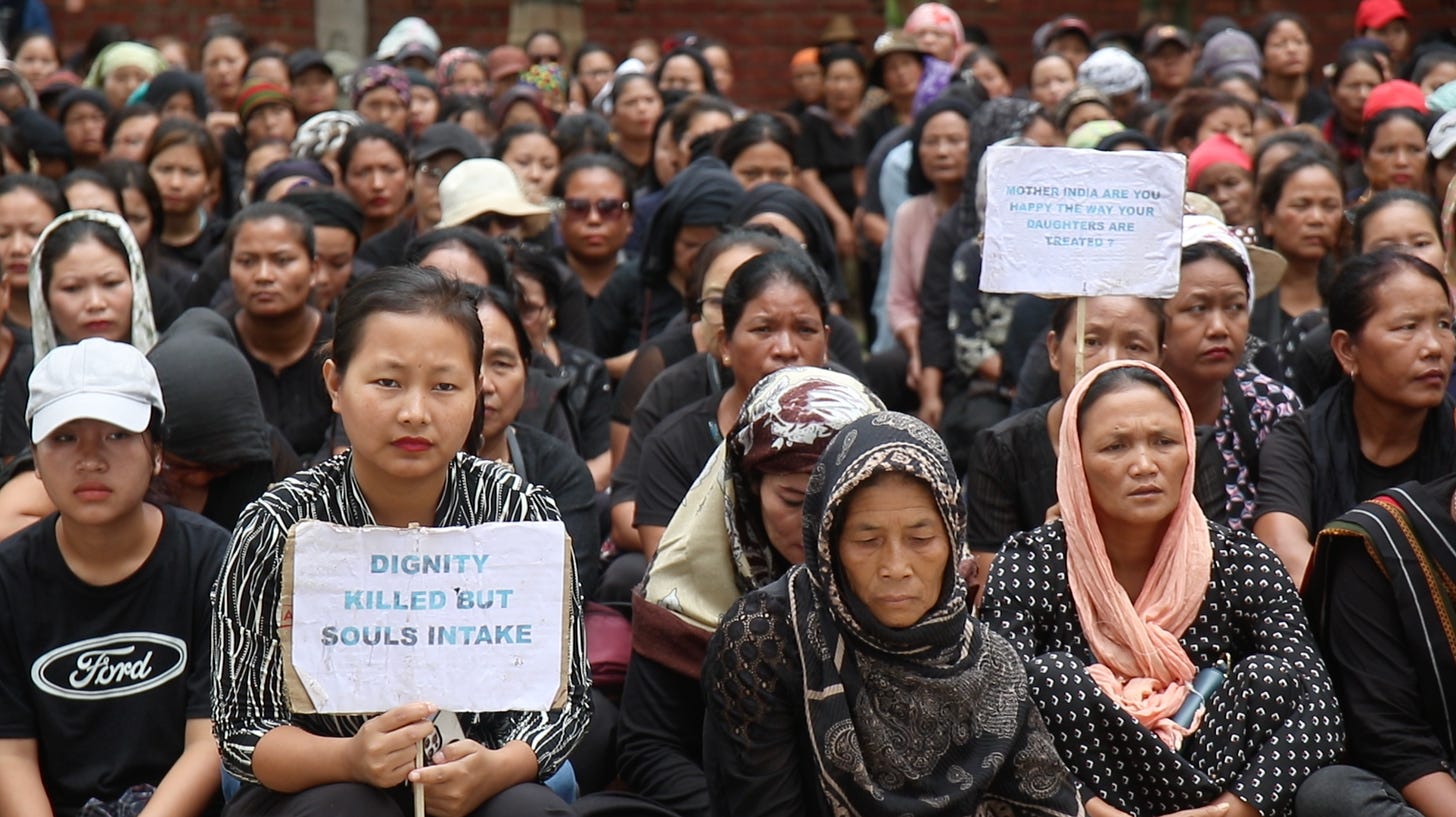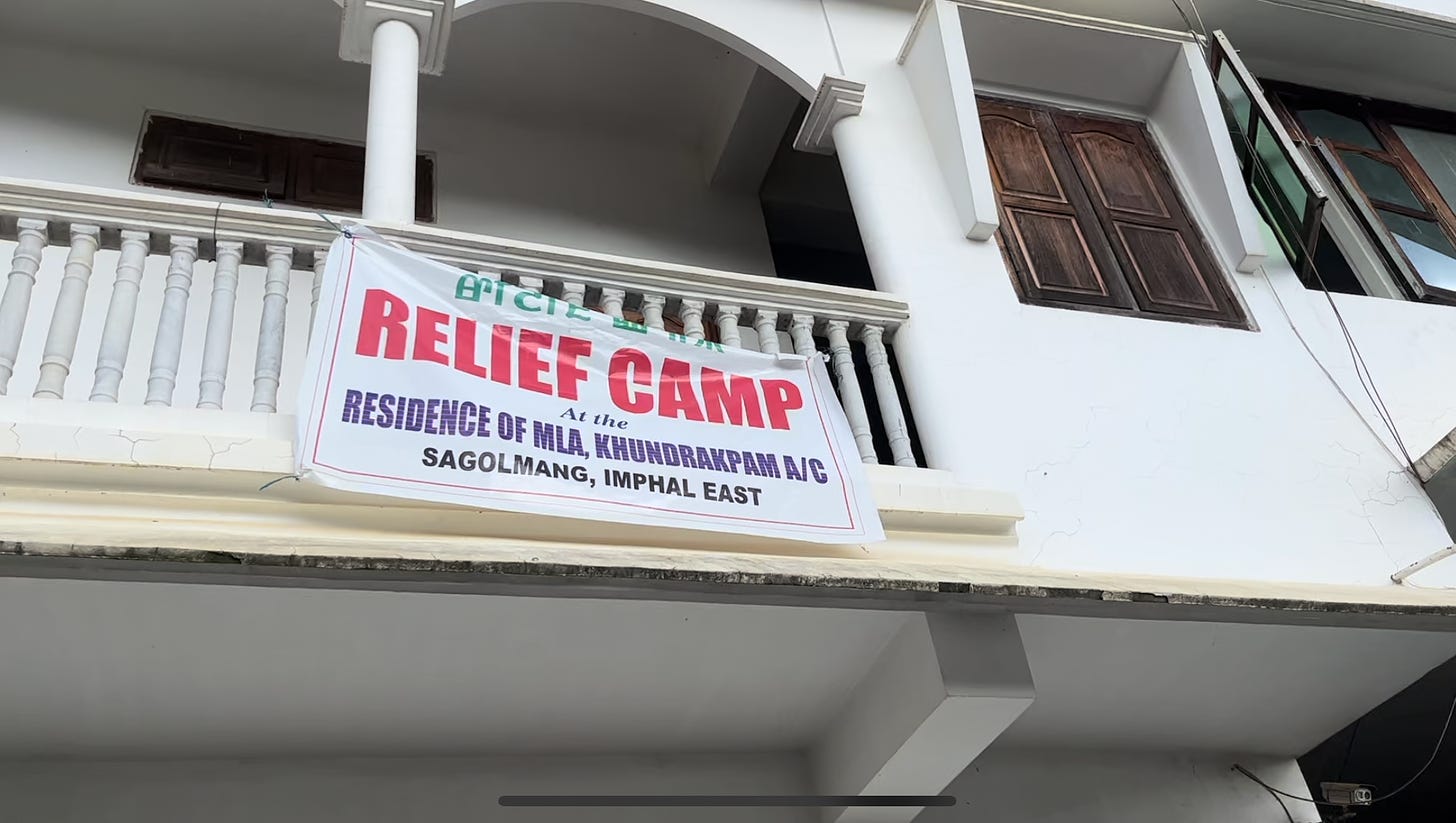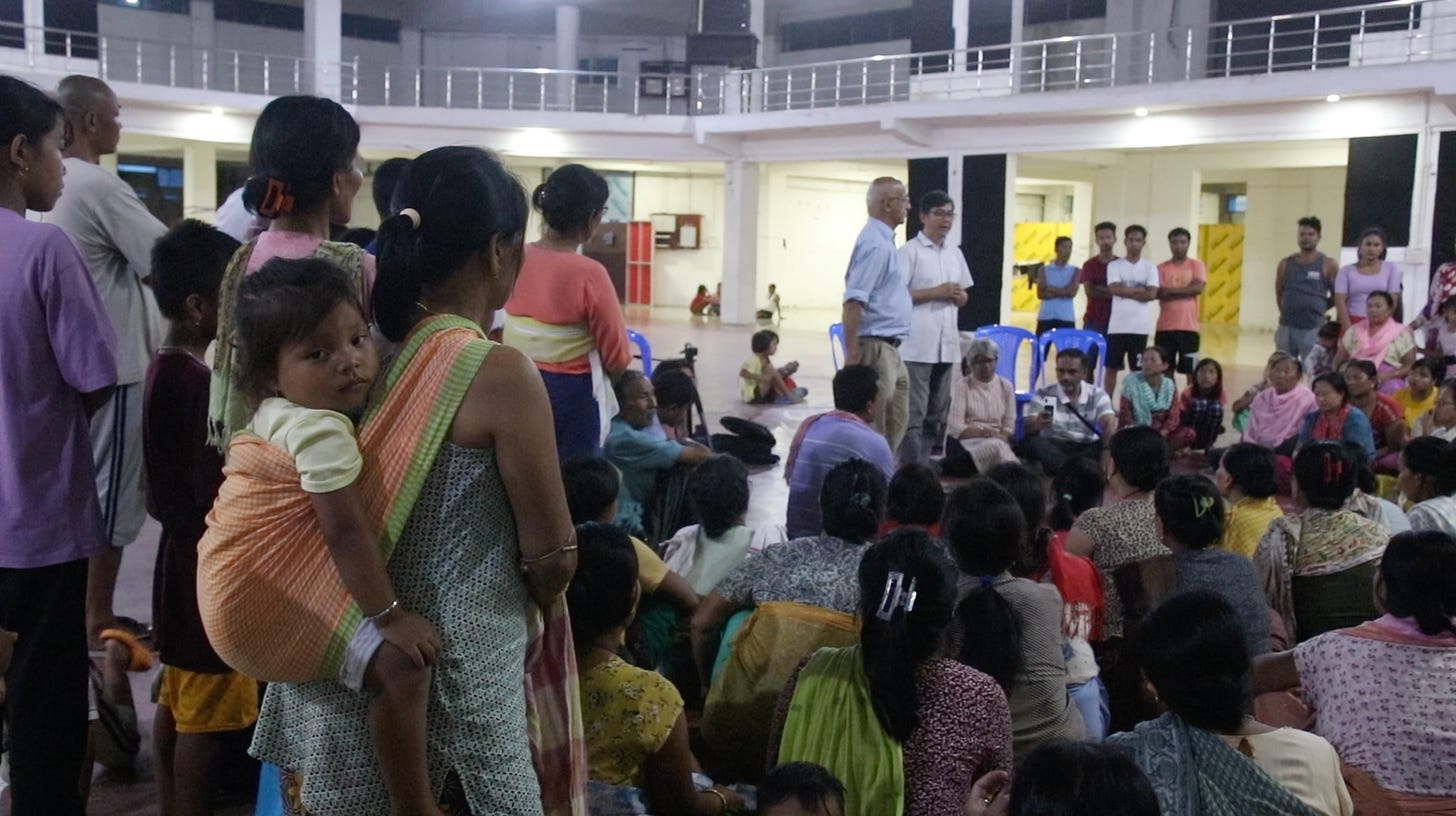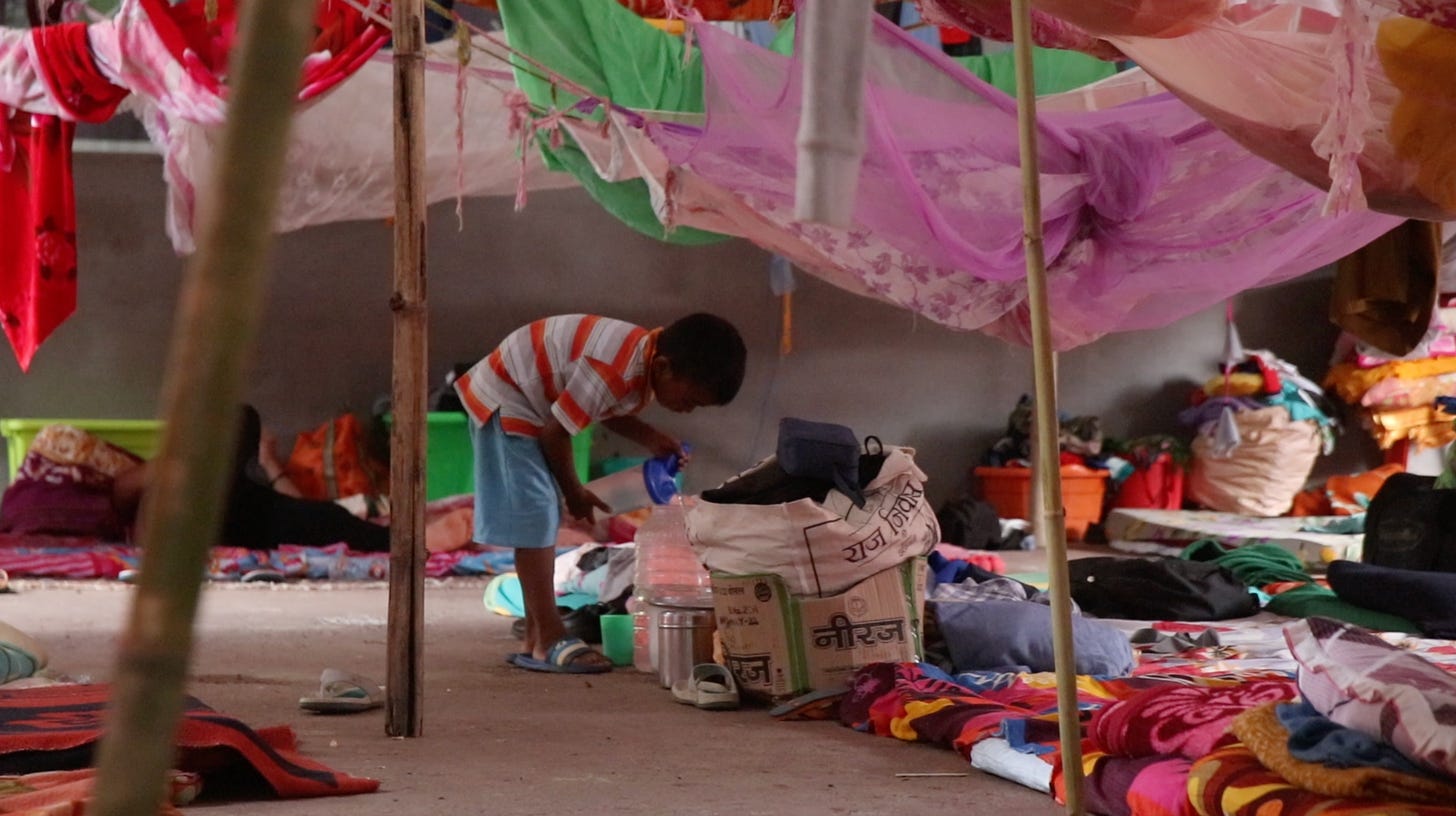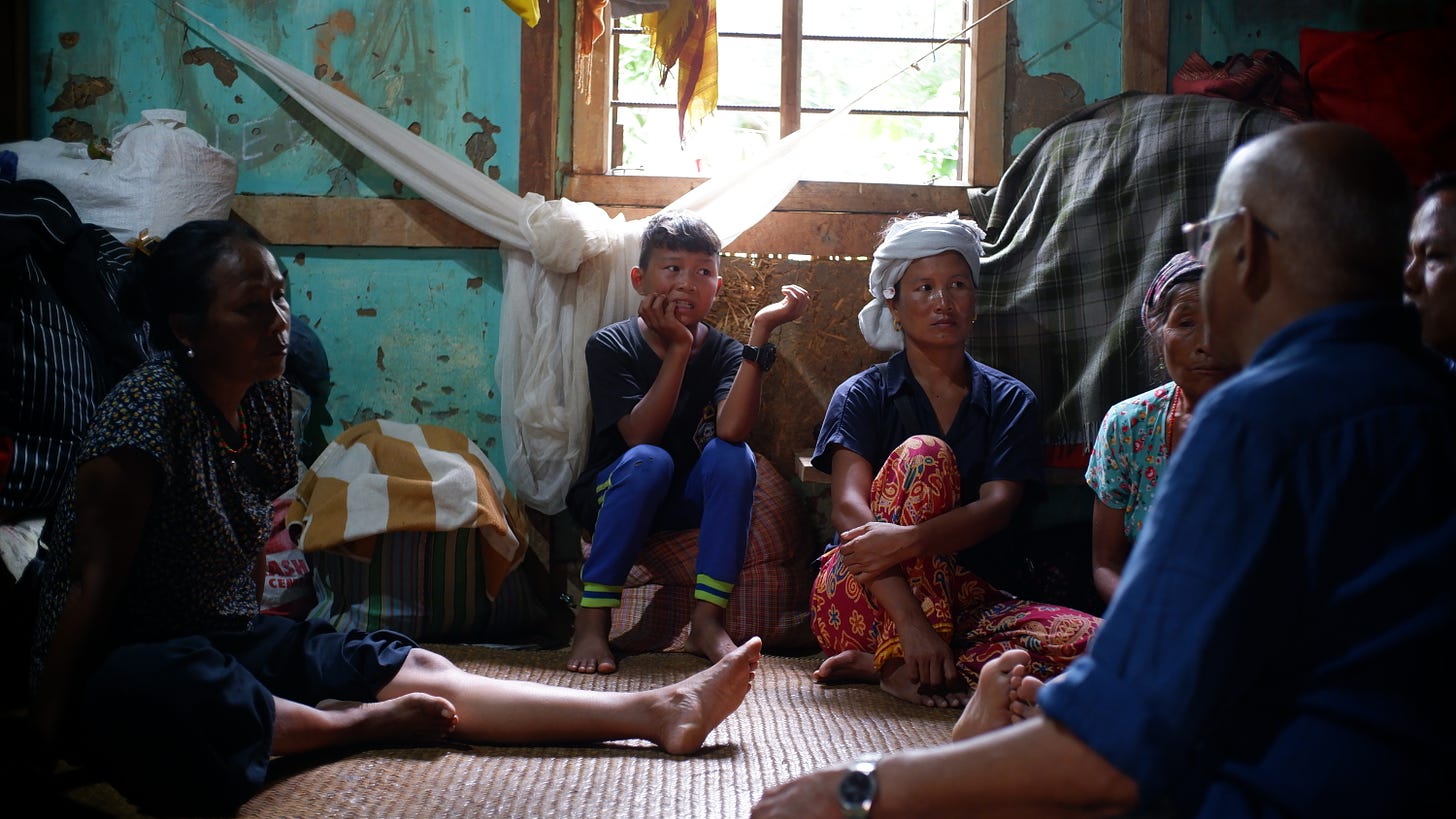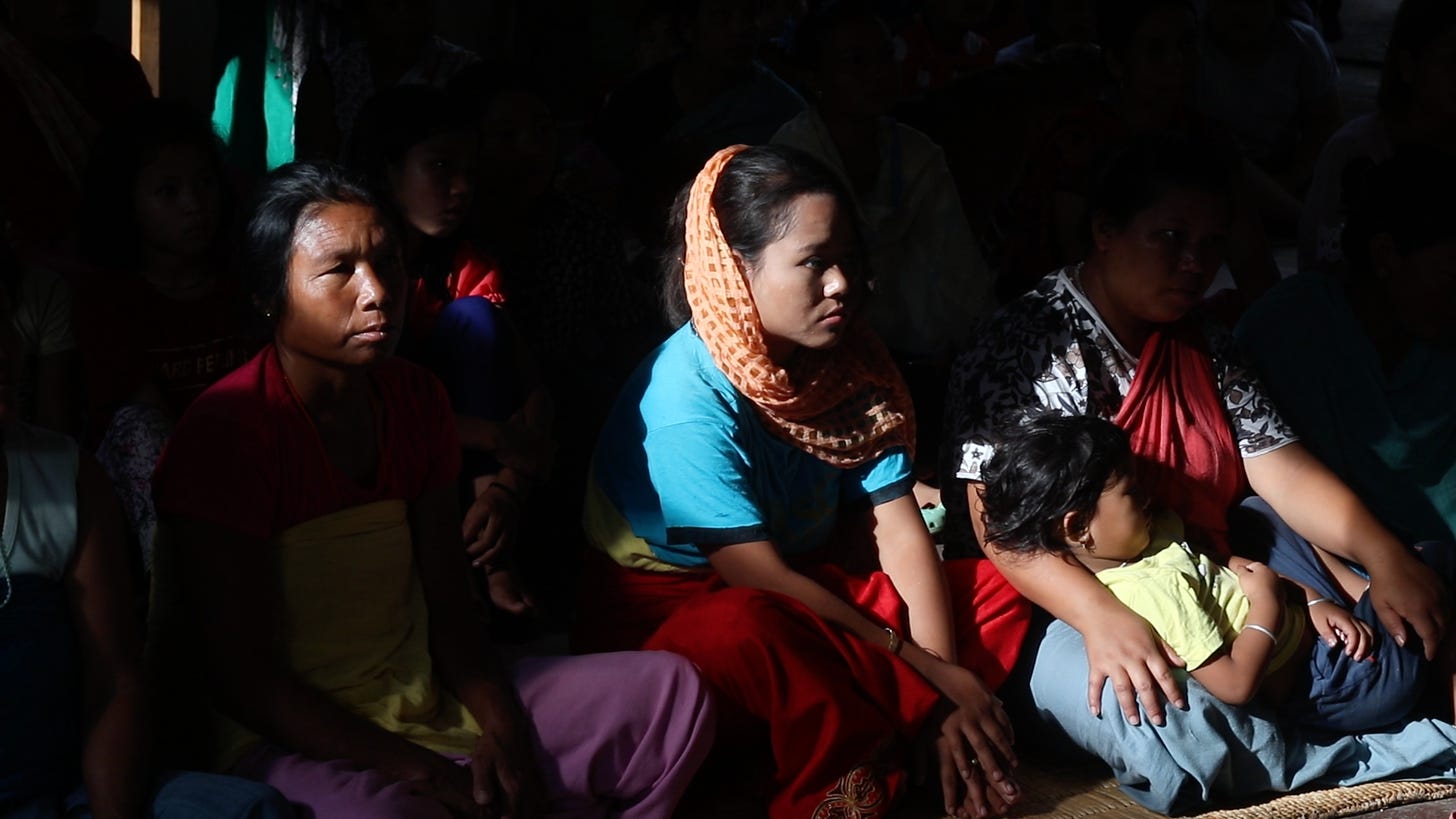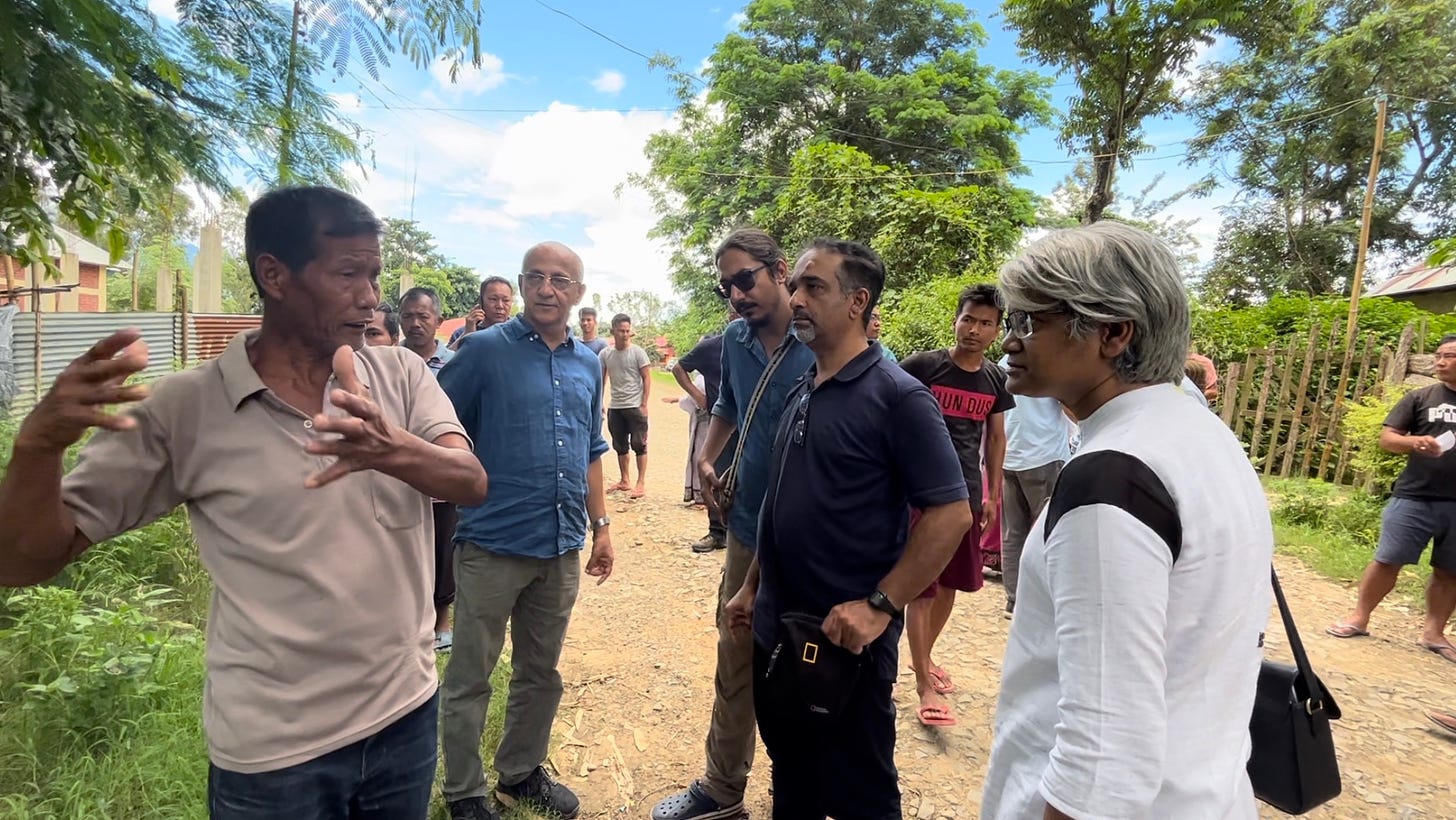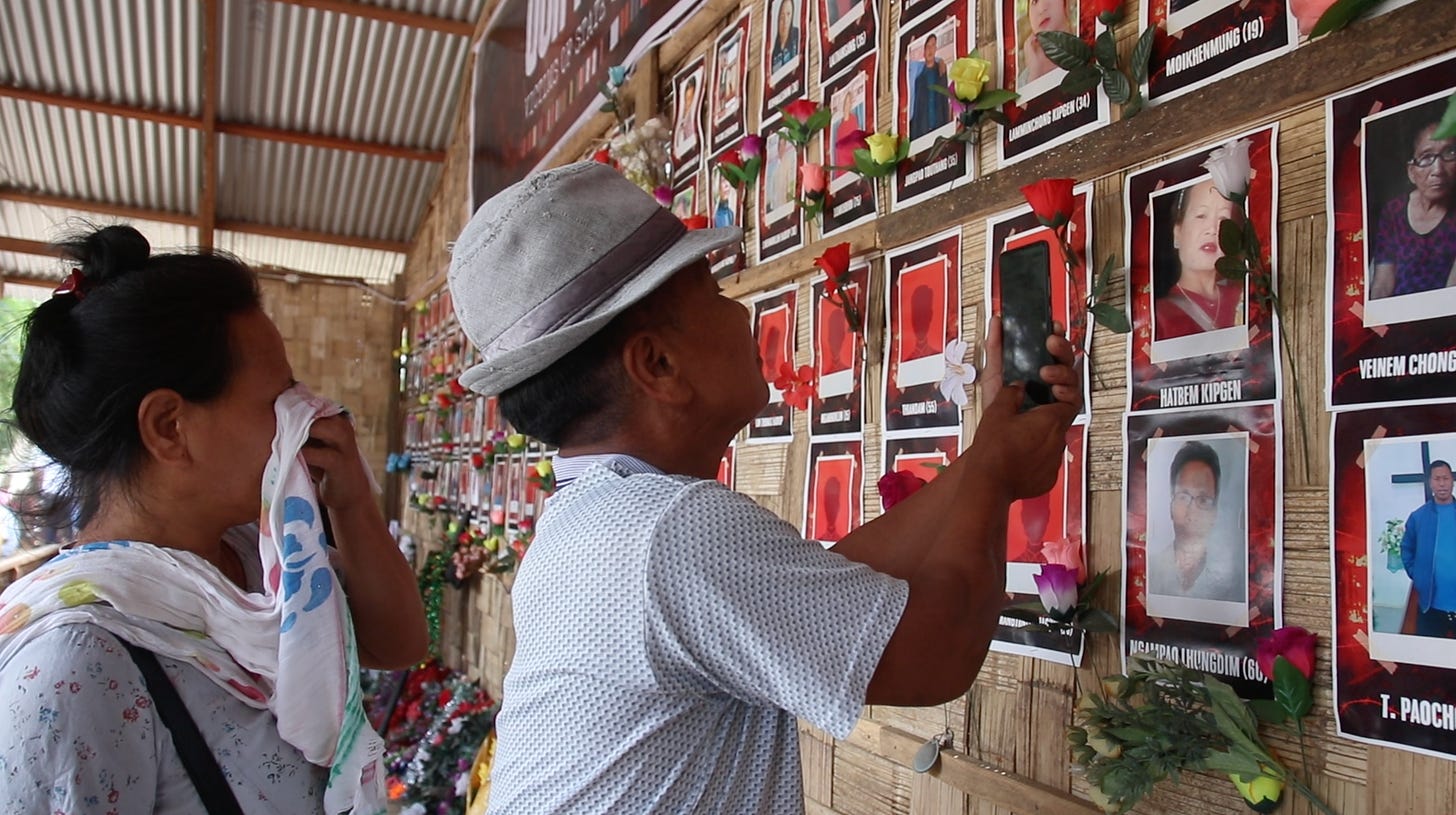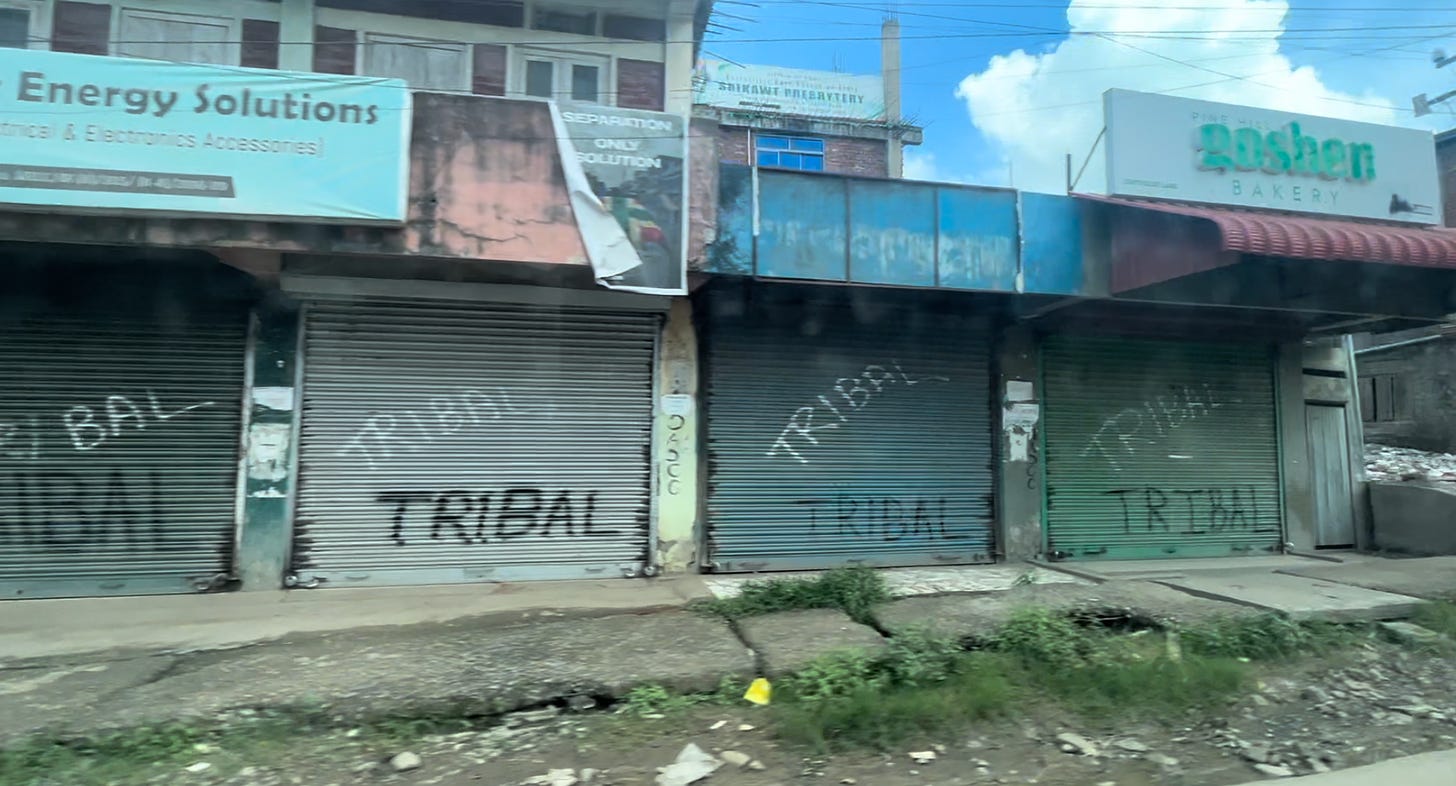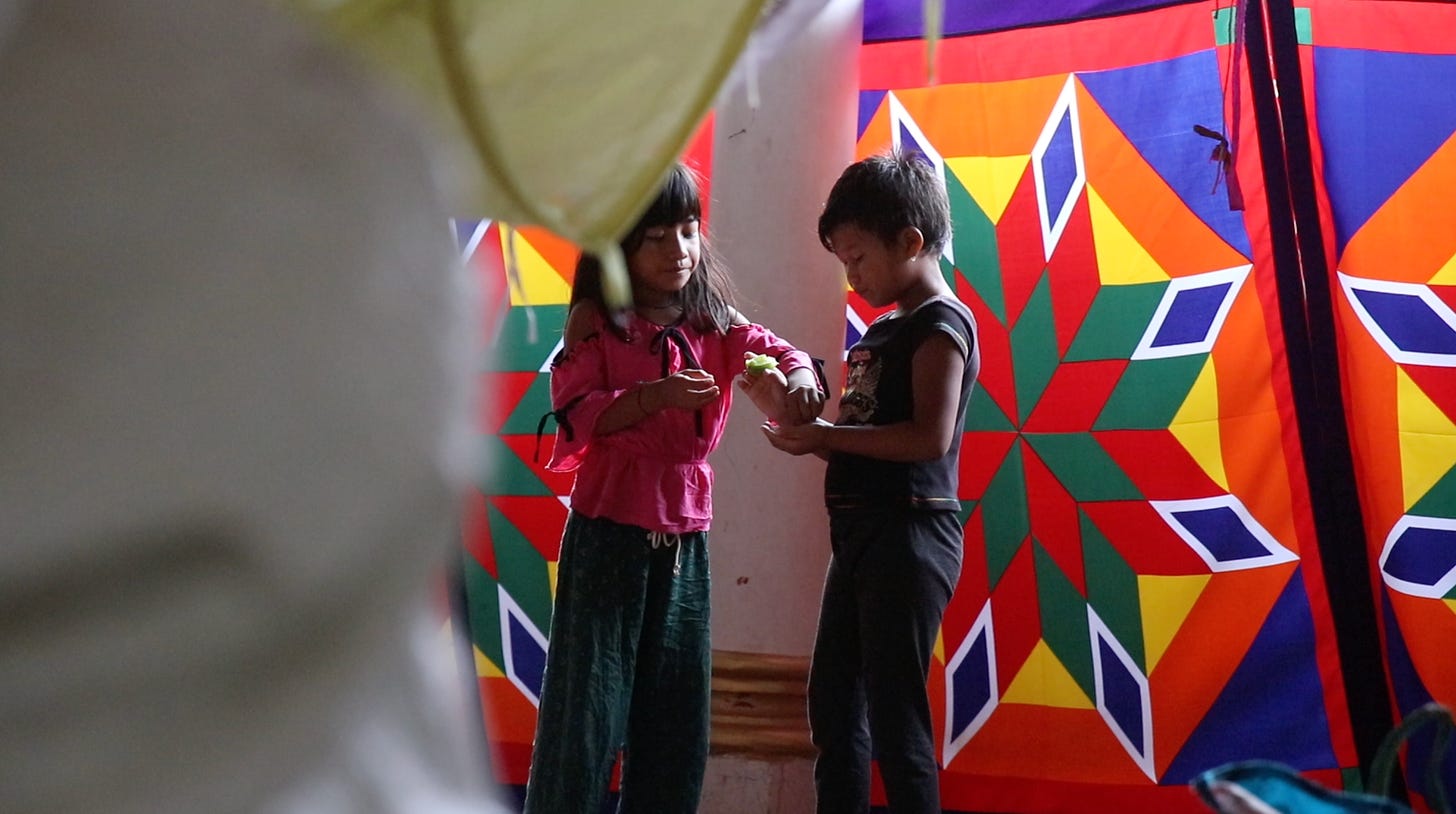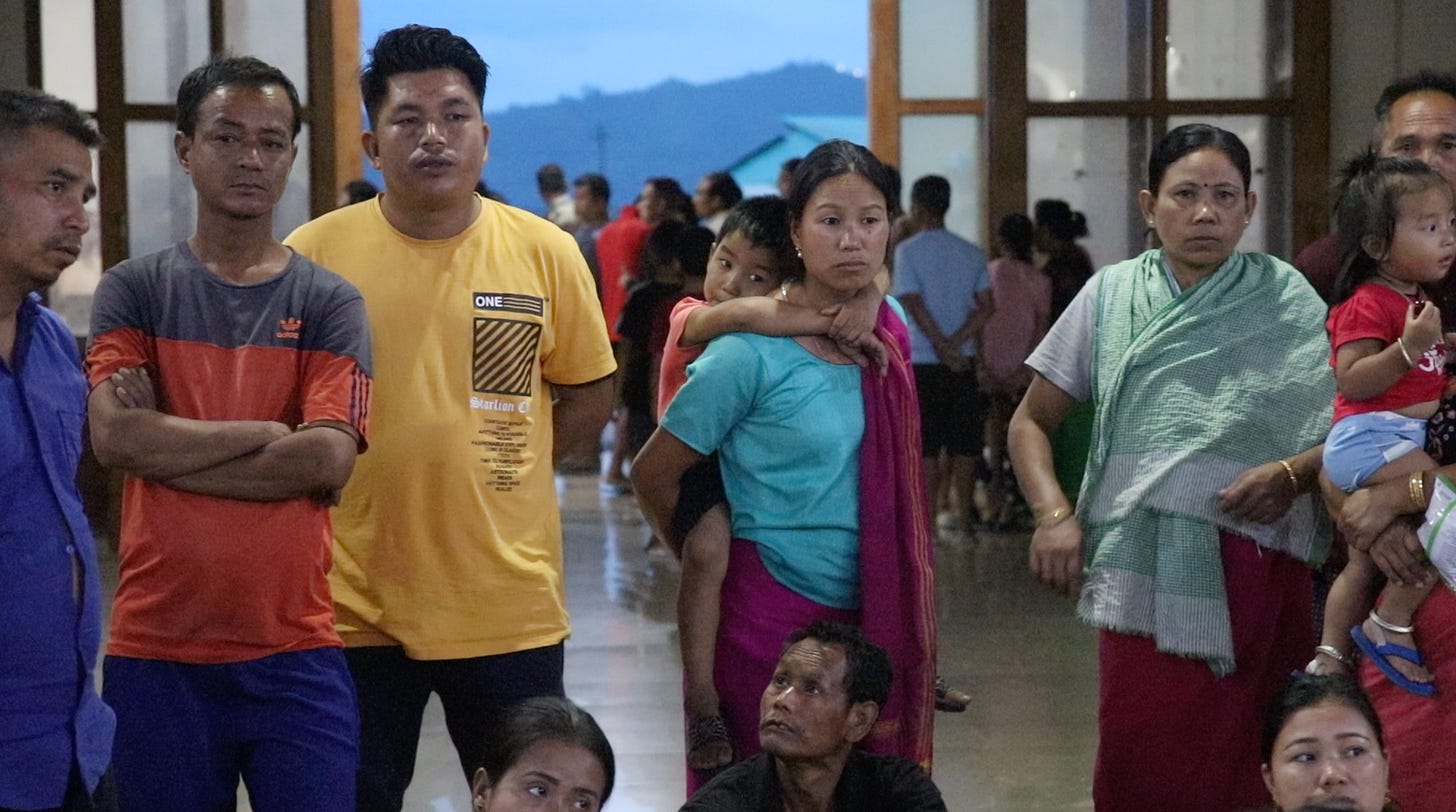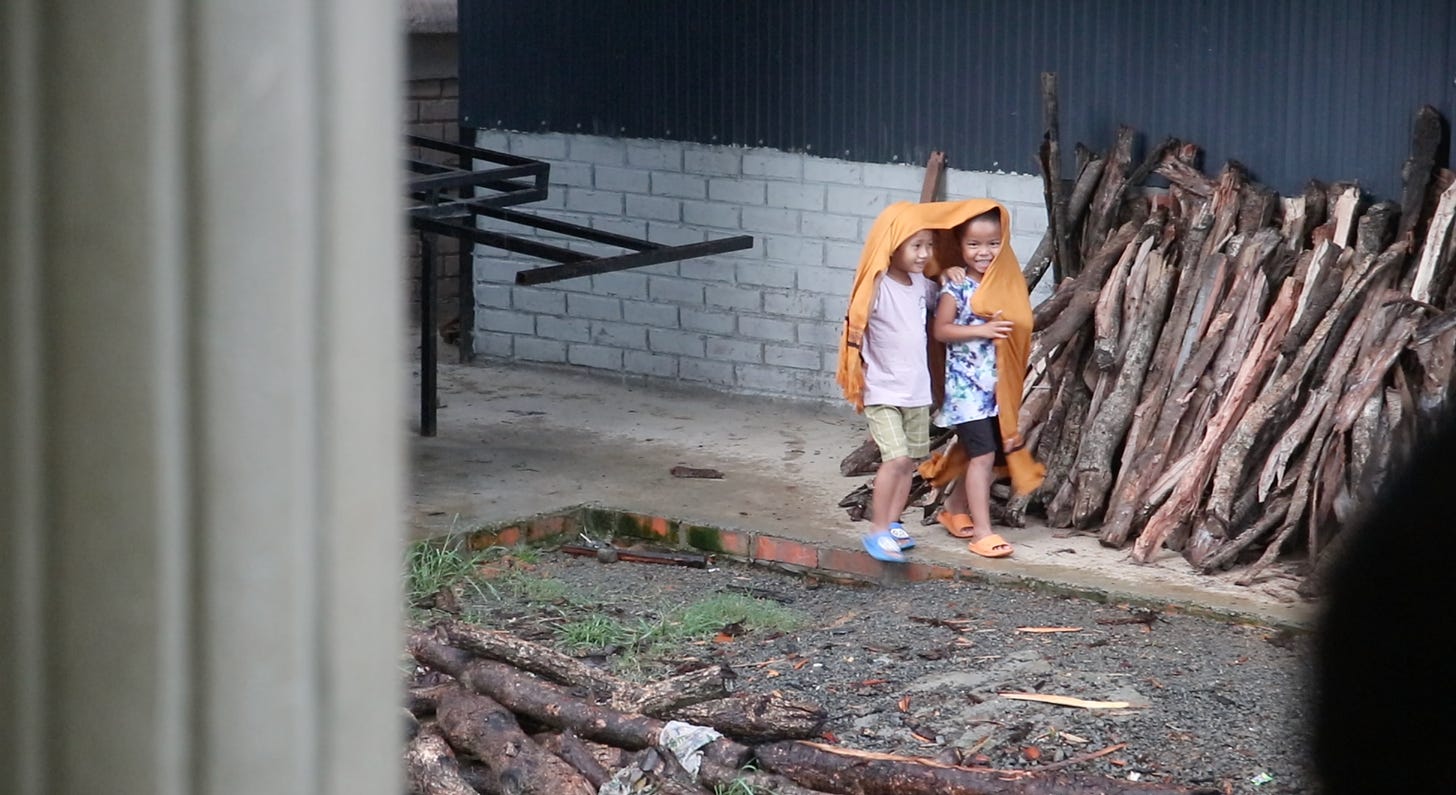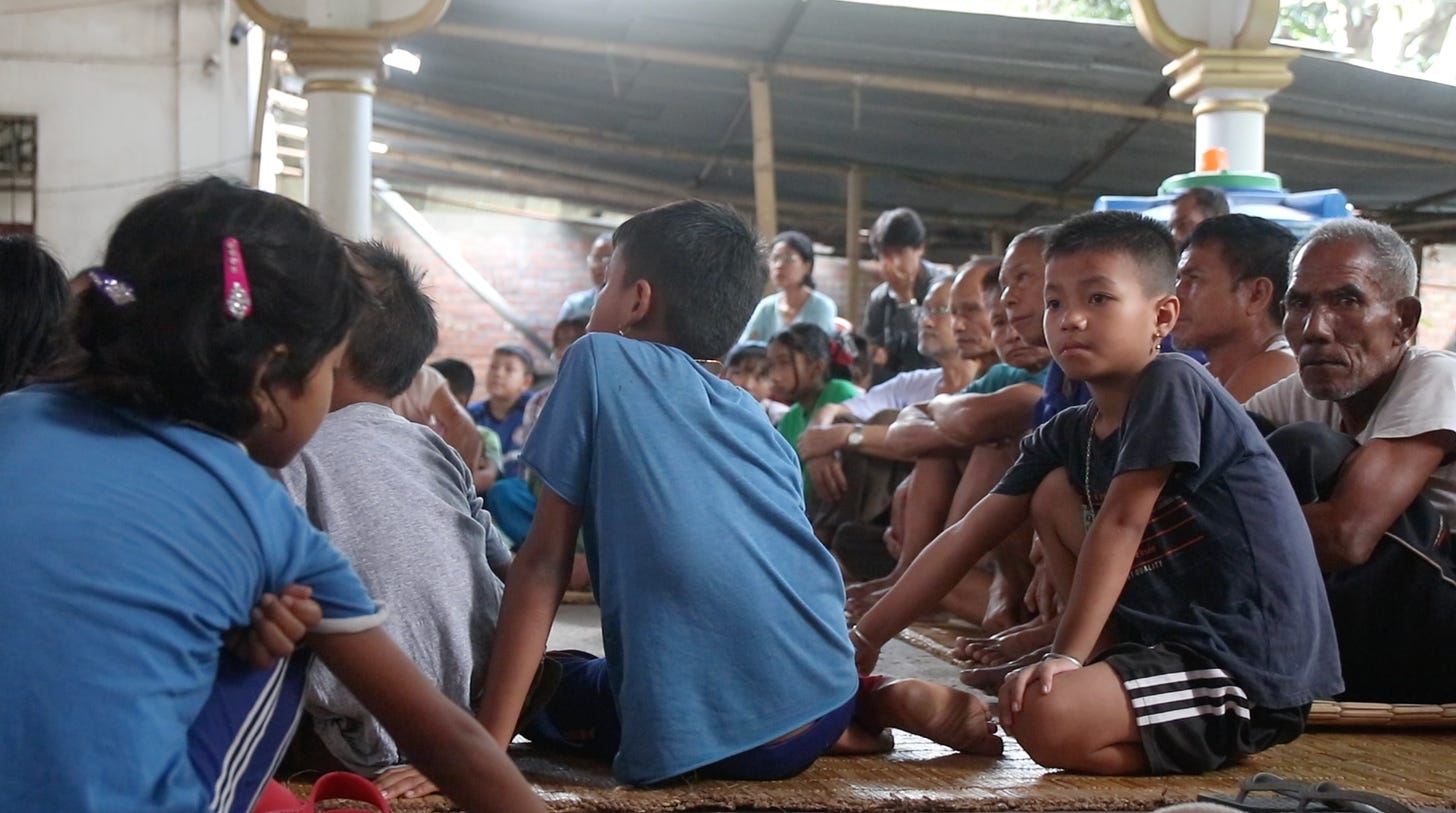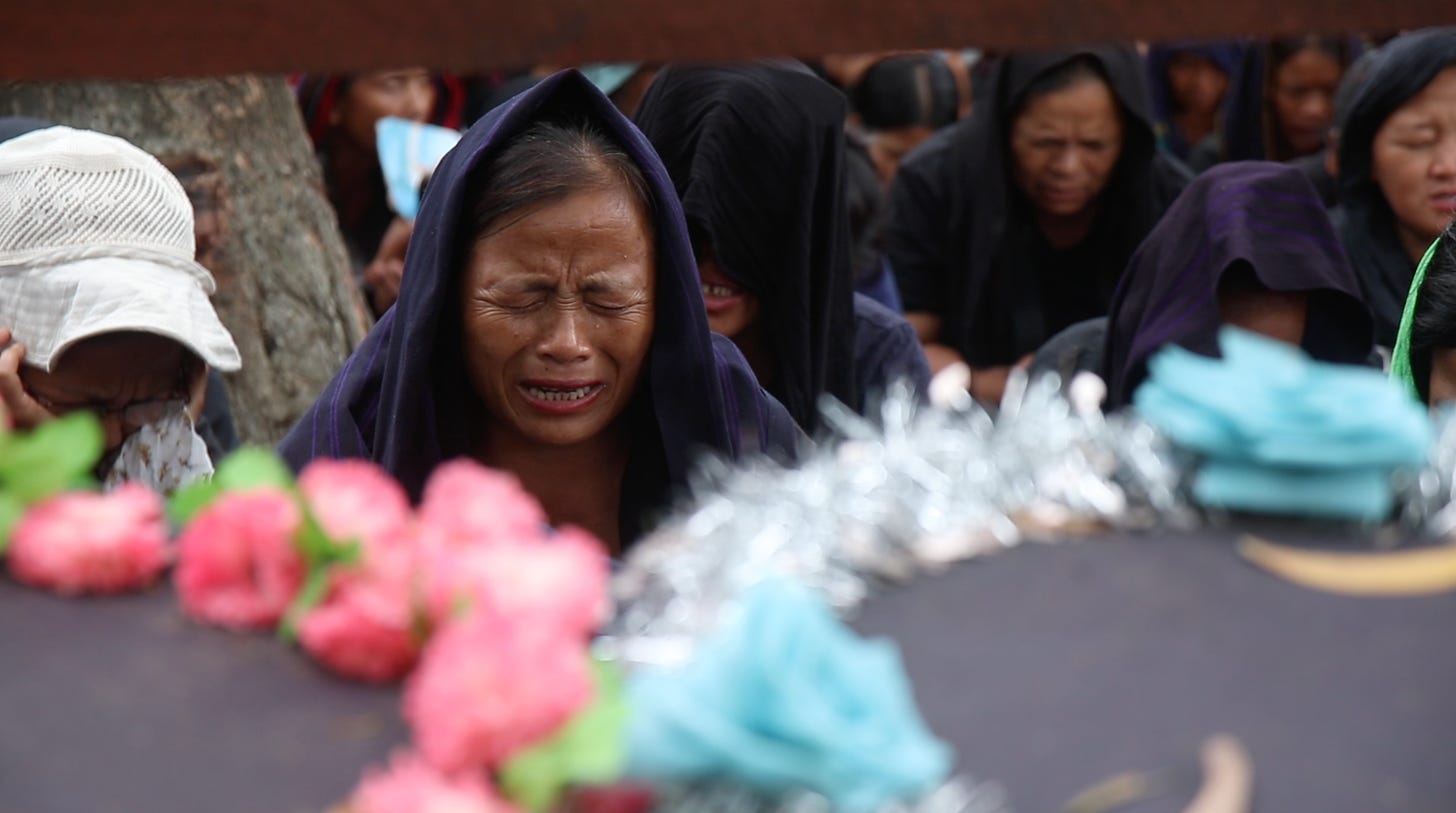The Humanitarian Crisis in Manipur - a report by Karwan e Mohabbat
We found a Manipur transformed into a war zone, bursting with sophisticated rifles, mortars, bombs, and massive daily mobilisation of ordinary civilians.
A team of the Karwan-e-Mohabbat (Caravan of Love) spent four days in violence-torn Manipur from July 25 to July 28.
The Karwan e Mohabbat is a citizen initiative which from 2017 has strived to reach out to victims of hate violence in far corners of the country, to offer solace and solidarity to the survivors. We spent in Manipur many hours listening to survivors in seven relief camps on both sides of what is now perceived popularly to be a “border” between the Imphal valley, home mostly to the Meitei, and the hills, inhabited mainly by the Kuki and Naga tribal peoples. We met scores of community leaders from both communities.
We found, in these four harrowing days, a Manipur that is beleaguered and broken. Nothing indeed had prepared us for what we bore witness to. We found a Manipur almost fully transformed into a war zone, bursting with sophisticated rifles, mortars, bombs, and massive daily mobilisation of ordinary civilians. (Even we were caught once within a few hundred metres of raging cross-fire and narrowly escaped).
Our travels within Manipur, our visits to the relief camps and our meetings with a wide range of political leaders was made possible because of the generous support of two finest community leaders, human rights defender Babloo Loitongbam and pastor Reverend Jangkholam Haokip.
The Karwan team to Manipur included veteran journalist John Dayal, community physicians Dr Meena Isaac and Dr Randall Sequeira, community psychiatrist Dr Rajesh Isaac, Surender Pokhal from the Evangelical Fellowship of India (EFI), Jatin Sharma, Director CES, Karwan Media Fellow Imaad ul Hassan, Karwan community leader from Assam Mirza Lutfar and Akanksha Rao, a Research Fellow at the Centre for Equity Studies (CES); and peace worker and author Harsh Mander. Each of them have contributed to this report.
Entire villages of both warring communities have been razed to ashes. Our foremost observation is that the state is led by a government that has done nothing to restore peace, and ensure justice against people who kill, rape and destroy homes with unfettered impunity even three months later. The state is absent in its foremost constitutional duty to protect civilians; it is absent from relief camps. Instead the state government is often perceived to be taking sides in what is quickly escalating into a full-blown civil war.
The grief, the rage and above all the hate on both sides are boundless. The grief in both Meitei and Kuki camps almost mirrored each other. Where Kukis were in minority settlements in the Imphal valley, they were surrounded by crowds with torches that set their homes on fire. The same happened to Meitei people who had lived for generations in the hill villages of the Kuki tribal people. The unbearable grief and rage of both were that neighbours of the “other” community, with who they had lived for generations with peace and goodwill, turned overnight into murderous and pitiless enemies.
They each recalled their fearful escapes, often trudging kilometres with children, sick and old people in their backs in the cover of the night. They spoke of pregnant women who gave birth as they escaped, of hungry, frightened babies whose cries they had to stifle. They spoke of people killed, of people who could not survive the arduous journeys. They mourned with us daughters abducted and sexually assaulted, and sons who never returned.
But it was their narratives of fury, of congealed and settled hate on both sides that worried us the most. We were struck first by how as people grieved inconsolably about the loss of their homes and loved ones, they completely erased from their memories the acknowledgment that people of what was now the “other” community had often suffered almost identical tragedies, even though the magnitude of loss and suffering endured by the Kuki-Zo people was greater. On both sides, people hadon the one hand been felled by the violence, and at the same time they had also perpetrated these same atrocities. They refused to carry not just the burdens of grief for what was done to them but also of culpability and guilt for what they had done to each other.
But even more gravely, we found that the same narratives of the evil of the “other” community were articulated whether we spoke to community leaders, students, women or residents of relief camps. The narratives of the Meitei people were that the Kuki people were foreigners who had illegally immigrated from Myanmar and would one day outnumber the indigenous Meitei people to who Manipur belonged rightfully. They had benefitted from reservations for tribal people to capture jobs and seats in educational institutions, while the Meitei are prohibited even from buying land in the hills. They accuse them of endangering Meitei youth by illegal poppy cultivation. They allege that the Kuki people are illegally clearing reserved forests for their farms and settlements, and threatening the ecology of the region. They claim that Kuki militants roam freely, and their violence and gun and drug trafficking thrive under the protection of the Assam Rifles.
The Kuki people have an entirely different narrative. They allege that their farmers may cultivate poppies for bare survival, but that the drug trade and profits are mostly harvested by politicians and big business in the Imphal valley and beyond. They claim to be legal citizens of Manipur, and allege that Meitei people want Scheduled Tribe status to grab their lands and reduce them to a minority in their mountain abodes. They also want to corner the seats in the legislatures and educational institutions that are reserved for tribal people. They also allege that a militia of Meitei youth is actively supported by the Chief Minister of Manipur, and that with open state patronage, it is these militants who ravaged their lands and people with rape, murder and arson. They allege long years of work by the RSS to convert Meitei nationalism into Hindu nationalism implacably hostile to the Kuki people also for their Christian faith.
And they believe that the Manipur state police and paramilitary forces protect the Meitei militants and those who raped and murdered.
The two narratives about the same lived reality are so utterly irreconcilable, that as long as people on both sides of the conflict are not willing to step down a few steps from what today passionately uphold as the truth of the evil “other”, there is no space for even a dialogue to begin.
In the midst of all of this, the state government has done nothing to establish and support the relief camps especially for an estimated twenty thousand Kuki internal refugees who have fled after their villages have been burnt down. It is largely the local church, supported by local contributions, that are running more than a hundred Kuki relief camps. Children in these camps have been reduced to eating watery rice with salt. Signs of malnutrition are already unmistakable. No camps have temporary schools. The refusal of the state (and central governments) to establish camps with basic services of safety, sanitation, nutrition, education and health care is another disgraceful abdication by the state of its fundamental constitutional duties.
We searched desperately for signs of hope in Manipur for peace and healing in the immediate future. We could find this only in stories we heard in the camps of people of the “other” community who helped save lives. These, and the acknowledgment of their shared suffering and indeed their shared belonging, alone can create the space even for the start of any dialogue.
We grieve for our people. We grieve for our critically fractured land. We rage for the malign governments that we have installed.
Focus of this Report
It will require extraordinary statesmanship to douse the fires that burn across Manipur, and to heal the fractures that tear it apart. The present state government – whose impartiality and competence are gravely in doubt - needs urgently to be dismissed. Special investigation teams - including police officers from outside the state and monitored by retired judges of the higher courts - need to investigate the crimes of the looting of armouries, murder and sexual violence, and the burning and looting of villages and homes. Civilian populations need to be urgently and extensively disarmed. Leaders of both estranged communities need to be brought together to restore a process of dialogue. These are just the first necessary steps to begin the long journey to restoring peace to broken Manipur.
But all of this is not the subject of this report of the Karwan e Mohabbat. There is no evidence that the steps we have outlined above to change the leadership, to investigate crimes, and to disarm populations, are likely to be undertaken in the immediate future. Without these, it would be impossible to rebuild trust between communities and a sense of safety that would enable the internally displaced populations to return to their villages and restart their lives.
The focus of the recommendations of this report is therefore centred on the immense humanitarian crisis that we encountered in Manipur. More than sixty thousand people have been displaced from their villages and homes. Most of these have been looted and razed to the ground. A majority of these displaced persons are living in relief camps. The state is almost completely absent from these camps, even more starkly from the camps in the hills. Since there is little chance today that relief camps will be wound up and normalcy restored in the coming months, the focus of our report is on the humanitarian crisis of the internally displaced persons, and what we are convinced must be done immediately to alleviate and prevent further human suffering in Manipur.
The Karwan journey in Manipur
The Karwan-e-Mohabbat (Caravan of Love) is a people’s campaign initiated in 2017 to fight against the rise in communal hatred with an abiding commitment to the values of the constitution - of equality, freedom, justice and compassion. It was initially crafted as a journey of atonement, solidarity and conscience in response to rising hate crimes and lynching across India. In September 2017, a team of volunteers travelled to 8 states, meeting families hit by hate violence, particularly of victims of lynching. The purpose of this journey in these tumultuous times across different parts of India most severely ravaged by mob lynching was twofold: (a) to respond with solidarity to the everyday fear that has settled in the hearts of Muslims, Dalits and Christians, and (b) to challenge and break the worrying silence of the majority with a call to conscientious action for promoting fraternity and solidarity with the survivors.
The Karwan has continued its journeys in solidarity with victims of hate crimes. It has made more than 35 journeys of solidarity to the homes of survivors of hate violence often in far corners of the country. In these journeys, we try to assure the survivors that they are not alone in their grief and loss; that we seek forgiveness and atonement; that we pledge to stay with them as they rebuild their lives and fight for justice; and that we will tell their story, through films, writings and public tribunals. In these ways, we try to respond to India’s rising darkness, by supporting the survivors with legal justice and social and livelihood support to rebuild broken lives; and by informing and trying to influence the public conscience.
Karwan e Mohabbat undertook a journey to Manipur to attempt to understand the nature and scale of the conflict and to offer support and solidarity to victims of hate violence and to assess relief efforts by the state and the central government. Numerous lives had been lost, villages and homes razed, sexual violence unleashed, livelihoods uprooted and thousands displaced in this humanitarian crisis which has continued for nearly three months up to the time of our visit. Over four days and three nights, from July 25 to July 28, on this Karwan journey we travelled in parts of Imphal and Churachandpur (Lamka), on both sides of the virtual border that tears apart Manipur in this frenzy of state-enabled violence. We met with affected people in relief camps, and community leaders, women and youth activists.
The Karwan e Mohabbat team broke initially into two groups that visited a total of five relief camps set up for the Internally Displaced People (IDP) in the Imphal valley. These included a camp set up by an MLA, Thongju Kendra Relief Camp set up by the Thongju Kendra Relief Committee in the Ideal Girls College building in Imphal East District, Wangjing Camp in Thoubal District, and Moirang College camp in Bishnupur District.
On its way to Churachandpur/Lamka, the team visited Phubakchao Ekhai - the virtual border of Imphal valley and the foothills. The team tried to visit a de-addiction centre at the adjoining village, but could not make it because of the armed hostilities around. This region had witnessed active violence, was heavily militarised and the locals were still reeling from the series of events that followed the eruption of violence in May this year.
We reached Churachandpur/Lamka after crossing about half a dozen checkpoints manned by various military and paramilitary contingents. In Lamka, the team first visited the Kholum Church Camp and spoke with members from the Kuki/Zomi community who had been affected by the violence. The camp housed about 28 families - over 135 people which were all from different villages. The second IDP camp visited here is housed in the premises of Songell Evangelical Church which provided shelter to around 150 people. The team offered tribute in the form of a multi-faith prayer meeting at the Wall of Remembrance that the community has constructed to commemorate the people who have been killed in the conflict. Once again, we met many community leaders. Our plans to visit more relief camps was cut short because of news of a fresh outbreak of violence and shooting, compelling us to cross the “border” to return to Imphal. The crossing of the “border” past the series of checkpoints was fraught, because the shooting, bombing and arson were under way in the close vicinity of the road in which we made our passage.
Conditions of Internally Displaced People at the Relief Camps
In the wake of the violence in May, an unconfirmed number of Meitei people fled the hill areas to the valley; and Kuki-Zo people escaped the valley areas for the hills. Some found shelter and safety staying with friends and relatives; but a large number, especially those who are more financially disadvantaged, have no succour and recourse other than to relief camps. Official data confirms that more than 57000 internally displaced persons (IDPs) are living in relief camps in both the hills and valley of Manipur.
In addition, an uncounted number of people have also sent their children, infirm relatives and women out of the state to relatives in other North Eastern states like Mizoram, Nagaland, Meghalaya and Assam, or to cities in mainland India especially Delhi. These are estimated by community leaders to number between 10 to 20 thousand persons.
Below is a summary of the observations of the Karwan team on the conditions and provisioning of basic amenities and services in the relief camps in Manipur.
Role of State and Central Governments in Relief & Rehabilitation
The Karwan team observed that the state and the central governments were almost completely absent from the relief camps. (There is currently only one camp, located in the Imphal valley, that is being run completely by the state government). They have failed not just in their primary duty of protecting civilians, but were also culpably absent from relief and rehabilitation efforts.
There was a visible disparity between the condition of the Meitei camps and the Kuki camps, though both failed in establishing adequate conditions of safety for the displaced and affected civilians. It was apparent that Meitei camps were being run with some government support - either sponsored by the local MLA or established in government buildings like colleges and sports complexes. This was not the case with the Kuki camps which were mainly being managed by the local church and supported by the community’s contributions.
As the conflict continues with no end in sight, we learn that families who gave shelter to displaced persons are now encouraging people to shift to relief camps. The population of relief camps is likely to steadily grow further, especially in the hills, and the consequent pressures on the community organisations that are organising the relief works in likely to grow even further.
Ex-gratia relief
On June 27, 2023, Chief Minister N. Biren Singh visited the relief camps in Imphal East and Imphal West districts to interact with the affected people and assured them of the government's commitment to assisting and providing for their basic needs. He announced then that the government will provide one-time financial assistance of Rs 1000 to those living in the relief camps, some 50,648 displaced persons in 349 relief camps in the state, according to government figures, and to be distributed through the respective district authorities.
However, our team were told by camp residents that many affected people both in the Meitei and the Kuki camps that they had either not received this amount or they had only received a portion of the promised amount, that is, Rs 500 or even lesser - Rs 100 or Rs 200 per child.
This amount of 500 or 1000 rupees amounts to just one or two days’ statutory minimum wages. It is both absurd and cruel to offer this as cash relief to people who have lost their homes and all their belongings.
The families have been managing on a day-to-day basis on borrowed and donated clothes and do not have the money or even the physical space to accommodate for any other personal belongings.
Cash compensation
It was during the visit of union Home Minister Amit Shah to Manipur that cash compensation of 10 lakh rupees each to the families of those killed during the violence, to be shared by the state and union governments.
However, no detailed scheme of cash compensation for victim survivors of the violence has been announced and implemented, including cash compensation for sexual violence, injuries, destruction of homes, livelihoods and moveable properties, destruction of places of worship, destruction of public institutions like schools, etc.
4. Infrastructure and protocols in relief camps
The camps that we visited in the valley (mainly housing Meitei IDPs) were in public buildings such as stadiums, schools and colleges (and in one instance, in a palatial home of an opposition MLA). By contrast, all the camps in the hill areas for Kuki-Zo IDPs were in church compounds, not in public buildings. Both sets of relief camps were overcrowded, but more so the camps in church compounds.
Monsoons have led to waterlogging in areas around the settlements. Lighting in the night from the living space to the toilets is lacking. Mosquito nets are sporadically available in some camps.
There are no protocols of accessibility and safety of vulnerable groups like unaccom
panied children, people with disabilities and senior citizens are present at any of the camps. New residents to a camp are even more vulnerable and usually receive less than usual standard accommodation. Rations are given in some camps to individual families means there is some level of indoor cooking without ventilation and chances of a fire hazard.
5. Camp management
The camps that we visited in the valley (mainly housing Meitei IDPs) were in public buildings such as stadiums, schools and colleges (and in one instance, in a palatial home of an opposition MLA). By contrast, all the camps in the hill areas for Kuki-Zo IDPs were in church compounds, not in public buildings. Both sets of relief camps were overcrowded, but more so the camps in church compounds. Monsoons have led to waterlogging in areas around the settlements. Lighting in the night from the living space to the toilets is lacking. Mosquito nets are sporadically available in some camps. There are no protocols of accessibility and safety of vulnerable groups like unaccom panied children, people with disabilities and senior citizens are present at any of the camps. New residents to a camp are even more vulnerable and usually receive less than usual standard accommodation. Rations are given in some camps to individual families means there is some level of indoor cooking without ventilation and chances of a fire hazard.
6. Sanitation, water and waste disposal
We found existing toilets are severely strained and in unhygienic condition and makeshift toilets are beginning to be built only in some camps. But drainage of the sewage is unplanned and a high number of insects and vectors are multiplying in the makeshift toilet drainage areas.
There is no provision of soakage pits near the water supply area or compost pits for solid waste/ designated safe burning areas. Safe storage areas for drinking water for individual families and designated hand washing areas with soap provision is absent in most camps.
Large breeding sites for mosquitoes and vectors, due to monsoons have developed in grey water flow areas and unplanned sewage areas and surrounding rice field drainage in some camps. Camp managers have largely rudimentary understanding of protocols in case of outbreak of any diarrheal or water washed diseases.
A large number of people, having the need to urinate at night, problems around incontinence as reported, with unsafe and unsanitary conditions around toilets further aggravate the morale of people still suffering from trauma and displacement.
While some camps have piped water for drinking, cooking, washing and toilets, most are in a precarious situation when it comes to availability of clean water. There are water tankers that come for delivery for drinking and water is stored in syntax tanks but chlorination and quality checks are rarely done.
The drinking water is being bought from private agencies by local relief providers and that for bathing is provided by PHED (Public Health Engineering Department) in Churachandpur district and villages.
Water for washing of clothes and utensils is further down on the list of priorities and there are regular shortages. Places for cloth drying are a premium and overlap with living spaces. Disposal of solid waste in camps is haphazard and segregation or final disposal have no protocols built in, leading to some camps having piles of undisposed waste.
7. Food and nutrition
In the Kuki-Zo IDP camps in the hills, food supplies are mainly being organised by local donations. In a time of extreme crisis, this is extremely challenging. The availability of food is therefore even more unstable and unpredictable in these camps as compared to those in the Imphal valley.
The minimum standards with respect to food in relief camps by NDMA (The National Disaster Management Authority) stipulate 2400 Kcal/day for adults and 1700 Kcal/day for children along with milk and dairy products as the minimum nutritional value to be provided. The food being provided in the relief camps falls miserably short of this standard.
The public health experts in the Karwan team observed that due to the lack of food support from the government, in many camps residents were eating only two meals a day without any diet diversity. There were no differential supplies for pregnant and lactating mothers, and younger children beyond 6 months of age who needed weaning food. We observed in a sample of camps in Churachandpur that a pregnant mother, a child or an adult of any age gets rice, dal and potato twice a day. Infants are fed just boiled rice with salt and water every day. There were also no extra or special rations for malnourished and sick people such as those with tuberculosis.
Not surprisingly, signs of both adult and child malnutrition with micronutrient deficiencies have begun to show in the camp residents. The availability of firewood and fuel was also found to be precarious. With the oncoming winter this will be a central survival issue for people at the camps
We looked at a sample of community health centres near the camps (for instance, in Moirang) and found that even here specific dietary supplements like vitamin A, deworming tablets, iron and folic acid etc are missing.
8. Health services
“Countries that host fragile, conflict-affected and vulnerable settings also have high burden of disease and death: more than 70% of cases of epidemic-prone diseases, such as cholera, measles and meningitis; 60% of preventable maternal deaths; 53% of deaths in children under age 5; and 45% of infant deaths.”
This data underlines the critical importance of public health initiatives in a conflict affected region. Some of the most important observations and suggestions made by the healthcare professionals in the Karwan team, are below:
The people in the camps in Imphal reported better access to healthcare services with weekly visits by physician. However lactating and pregnant mothers seemed to be struggling to get adequate attention for their problems.
In the Churachandpur district and villages, healthcare access was limited to a visit to the district hospital when required. The physician visits some camps when called by certain relief agencies. The health centre, even if present near the camp, was not mentioned by the people as an option in times of illness.
One reason is an acute shortage of doctors. It is important to understand that the divide between the estranged communities has also divided doctors and health personnel. It is unsafe for a Kuki doctor to serve in the valley, as much as for a Meitei doctor to work in the Kuki dominated hills.
On being asked, where she would go for emergency medical care, one of the camp inmates said that she would have gone to Imphal but under the current circumstances that was not an option, and so she didn’t know where to go. The pregnant women also did not mention the nearby health centre as an option for delivering their baby. Immunisation of children was also mostly being accessed at the district hospital. People reported dissatisfaction with the services at the district hospital also because of shortage of physicians. Systematic primary healthcare at or near the camp was not visible. There was no mention of visits by ASHA or ICDS workers in the camps. All the referrals from the district hospital would normally be made to the tertiary care facilities at Imphal but presently all such referred patients have to take an expensive ten-hour long road trip to Aizwal, Mizoram to access tertiary care. But there are no critical care ambulances available for this.
People across the camps, including women and elderly people, reported a severe shortage of medicines especially for people with chronic diseases, heart patients and diabetic individuals. Medical supplies are threatened so badly also because of a blockade on the travel of trucks with supplies of medicines (and also food) from the valley to the hills.
Pregnant women also have to be sent to different camps since there is no gynaecologist or maternity specialist available when needed. People have to spend out of their own pockets for accessing consultation and medicines related to chronic health issues.
The overcrowding, unsanitary conditions, food deficit means the camps are ideal locations for diarrheal and viral disease outbreaks and epidemics. This prolonged misery can further lead to epidemics of tuberculosis and worsen prevalence of HIV and drug use.
There are no functioning protocols or supplies to deal with acute malnutrition at the camps as run by the camp managers. The children need growth monitoring and malnourished children need to be identified for therapeutic interventions. Outbreaks of viral rash diseases have already occurred, (claimed as measles /chickenpox) and lack of isolation spaces in all camps for patients is evident as well as skin diseases due to overcrowding and unhygienic conditions. Stigma and cultural taboos are also leading to lesser reporting of these problems especially among women. Specific household utensils for those who have none due to the displacement and undergarments and sanitary pads for women are in short supply. With the onset of winter there will be a need for firewood for warmth and blankets both of which are in short supply.
9. The absent state from the hills
We found the state absent not just from the relief camps in the hills, but even from other elementary public services. For instance, in the public hospital and medical college in Churachandpur, it is not the state government but local community groups that are struggling to supply food in the relief camps, are also making arrangements for supplying food to the patients, the staff and the medical students.
Likewise, medicines are being bought and organised in the public hospital by local charity and church groups and not the state government. There again are no funds for diagnostics. There are 104 pregnant women in the camps, and local community leaders spoke to us of contacting Christian Medical College, Vellore for sonography machines to conduct ultra-sound investigations of the pregnant mothers.
Because it is unsafe for patients that need advanced medical care to be taken into Imphal, they have no option except to take the 12-to-16 hours’ hill journey through damaged roads to Aizawl in Mizoram. But there are no ambulances with life-support systems to enable critically injured and ill patients to make this journey, so lives are being lost.
10. Education and youth activities
We found no schooling and educational services especially in the camps in the hills.
Most children under the age of 5 are cared for by camp elders and mothers and there is no connection or enrolment in the nearest anganwadi ICDS centre.
Older children are in the same way unconnected to the nearby school. A few school-going age group children in the Meitei camps have been enrolled in the nearest school but most children in the Kuki camps have only informal school education provided by camp volunteers in a few camps. A number of schools run in the Kuki hill areas had Meitei teachers and now are lying defunct
Youth in the camps are drawn into becoming front line village defenders and recruited for protection along the informal border areas and bunkers with almost no adolescent and young men left in the Kuki camps.
Young girls in the Meitei areas are getting drawn into wage labour in the rice fields where earlier they might have been getting educated at the local school or college.
There is idleness in camps, a lack of education, no potential for dreams for the future as well as a lack of a dignified place to call home in the IDP camps
Although there was no internet in most places, Bluetooth was used to transfer propaganda videos, audios, and text multimedia files of brutality of the other community as well as real videos of displacement and burning of erstwhile homesteads and villages which is further fuelling hate and despondency among the youth.
11. Very limited opportunities for livelihoods
Seasonal work in agricultural fields especially in the valley areas is going on and providing some limited employment opportunities for men and women in the camps in the valleys. But this is not available in the hill areas.
Trainings on candle making, agarbati making and stitching have occurred in some Meitei camps, undertaken by various NGO’s and provide some opportunity for makeshift livelihoods but the market for these products needs to be further explored
Militarization and fear of attacks on the informal borders means a lot of IDPs as well as border village people are engaged mainly in nightly and daily vigils rather than to be engaged in fruitful livelihood building activities.
As stated earlier, in the Kuki camps, most of the young men have volunteered to become village defenders, while there is considerable strain on village communities to provide livelihood support to people left behind in IDP camps in their localities.
12. No clear pathway away from the relief camps to normalcy
The Chief Minister of Manipur had promised that his government will build 3,000-4,000 pre-fabricated houses to accommodate the people who had to flee from their houses during the ongoing violence. Prefabricated houses are ready-made structures that are constructed off-site and assembled at the place where the homes will be set up. He assured that all concerned would be housed at the temporary housing facilities till the law-and-order situation improves or the families could return to their respective homes. The government announced that efforts are on to inaugurate a housing facility near Sajiwa jail to provide residence to displaced individuals from Imphal East. “For those displaced from Churachandpur district, temporary settlements will be built at Kwakta in Bishnupur district. When the situation improves, all the displaced will once again return to their respective places,” the chief minister said.
Many affected people at the Meitei camps, especially the ones who had to flee from Moreh amidst rising tensions, wreckage by mobs and markets being burnt down, expressed that they now wish to go back to their homes. They do not want to live in a temporary housing facility in the valley; they had a comfortable life and livelihood in their hometown and lived alongside different communities including Kukis. There is no evidence of any process initiated by the government to rehabilitate the displaced communities, and particularly to create conditions to bring the estranged communities together again.
But what is most conspicuous is that for the Kuki-Zo people displaced from the valley, there seem no efforts at all by the state government in Manipur - at least not in the public domain - to assist them to rebuild their villages and homes in places where they feel safe in the future.
13. Hidden mental health epidemic
Perhaps the most alarming finding is of a growing hidden mental health epidemic, manifesting itself both in wide-scale depression and, among young people, a visible and dramatic rise, especially in the hills, of alcohol and drug abuse.
This follows the pattern already visible in other sites of armed conflict and militancy, like Punjab and Kashmir. There seems no effort whatsoever at the level of the union and state government to anticipate, prevent and address this hidden epidemic, that carries within it the threat of losing a whole generation.
5. Recommendations to deal with the intense humanitarian crisis of internally displaced persons in relief camps in Manipur
Our paramount recommendations in this report relate to the monumental humanitarian crisis of a Manipur which has been converted virtually into a war zone. Most of all, we demand that the union and state government fulfil their constitutional role to lead efforts for relief and rehabilitation, correcting their culpability of near absence so far in fulfilling their duty to heal, protect, offer solace, safety and ways of rebuilding their savaged lives, and indeed to one day in the not-too-distant future return to their normal lives.
These are people displaced from their villages and homes because these have been razed to the ground or ransacked; people who have suffered brutal hate violence including sexual violence; people who have lost loved ones to this ongoing hate violence; of people who continue to live in daily fear of further escalation of violence.
What the state must do to prevent and assuage human suffering in the warlike conflict conditions in Manipur is not difficult to conceptualise for a state that treats every human life, of people of every identity, of equal worth and value; and is mindful of its duty to restore them to a life of dignity and safety.
We will end this report with a few suggestions for humanitarian interventions to address the suffering of the Manipuri people. These suggestions are more illustrative than exhaustive; and while they address mostly the union and state governments of India and Manipur respectively; they also make a call to the country’s leading humanitarian agencies to strike roots for a long mission of healing and justice in wounded Manipur.
1. The union and state government must announce a comprehensive relief and rehabilitation program for all affected people, including but not restricted to compensation for death, sexual violence, injury, disability, and loss of moveable and immoveable property; but also, the running of humane and dignified relief camps, and helping people affected by the violence to rebuild their homes and habitations in accordance with their wishes.
2. The state government, with strong and visible support from the union government, must take direct leadership of all relief and rehabilitation tasks for people hit by the ongoing warlike conflict.
3. The state administration must directly administer all relief camps in both the valley and the hills. The Chief Secretary for the entire state, and the District Collectors of each district, must be directly accountable to ensure that every relief camp fulfils standards laid down by the National Disaster Management Agency and international standards for IDP relief camps. Each camp should be managed 24x7 by teams of government officials appointed by the DCs.
4. All costs of food, water, sanitation, health care, education and other services in relief camps must be borne by the state government, with necessary assistance from the union government, and not by community organisations.
5. The union government must assist with all the resources that are required for a high standard of relief and rehabilitation of IDPs from the conflict. (The Union Ministry of Home Affairs has announced a Rs 101.75 crore relief package supposedly for displaced people. However, not only is too small a package for implementing comprehensive and humane relief and rehabilitation; the details of this package and when and how it will be disbursed are still not available in the public domain).
6. All camps must be housed in government buildings like stadiums and college buildings. These must be spacious and well-ventilated, with good drainage. Additional toilets with safe sewage disposal must be built for every camp on priority; and scientific arrangements made for waste disposal. Permanent toilets with good sewage drainage for all categories women, men and those with frailties and disability must be built within a short time frame.
7. The state government must ensure that blockades on the movement of food, medical and other essential supplies are firmly removed, and safe passage of all such transport is ensured. It should urgently establish of a safe road corridor in and out of the valley towards the north and south for humanitarian aid and ambulances with outlawing of searches and confiscation by any citizen group of the aid passing over from hill to valley or vice versa.
8. With immediate effect, the state government must restore its full presence and responsibilities in the hill regions of the state. This would include responsibility to supply food for patients, staff and medical students, as well as drugs and diagnostics, in the medical hospital and medical college in Churachandpur. The state government should establish both an air ambulance services as well as supply at least three critical care ambulances for transporting critically ill and injured patients from Churachanpur to Aizawl or Guwahati.
9. While the leadership, resources and legal accountability for the relief camps must vest with the administration, there should be high and systematic participatory joint management by residents of the camps.
For this, firstly, a representational channel for camp inmates to participate in camp governance as well as communication with their government representatives (council members, tribal chief, local MLA, etc) needs to be established and formalised in discussion with and consent of members of the camp
The official team leaders should also appoint management committees, drawn from and chosen by the residents of the camps, for overall management, as well as specific committees for food, water, sanitation, health care, education and other services. The camp resident committees must have equal numbers of women and men, and include youth and older people, and persons with disability. Resident committees should also assist in along with first aid and emergency protocols, youth engagement, psychological support for inmates, focus on vulnerable groups, makeshift livelihoods and peace and morale building measures.
There is need also to develop standardised protocols and training for camp managers – both officials and the committees of residents - in the areas of shelter and settlement, food security, health, and water and sanitation; and regular monitoring and evaluation by social audits.
Data management systems through checklists, records, financial bills, and stock registers should be developed for each of the above-mentioned areas, in standardised formats. This would help also to identify gaps in basic amenities and services at the camp.
There should be in addition independent and transparent committees for grievance submission for redressal and for complaints of sexual harassment and child abuse.
10. Each camp should have adequate numbers of fully staffed and resourced temporary mini-ICDS centres, at the minimum ratio of one for every 40 infant and children under 6 years who are resident in the camp. These should provide the resident children and pregnant and lactating mothers a full range of services including supplementary nutrition, growth monitoring, vaccination and early childhood education.
11. Each relief camp should house at least one fully staffed temporary sub-health centre, and at least one ASHA worker for every 200 residents. Once again, these should offer their full range of services. On the one hand, these should provide pre- and ante-natal services to pregnant and lactating mothers; and on the other, vertical programs such as for TB and HIV.
Free and regular supply of sanitary napkins, and sufficient quantities of clean clothes and undergarments, and bathing and washing soap must be ensured for all residents.
A full list of public health services is attached in Annexure 1.
12. The state government must ensure that all schools in botht he valley and the hills are reopened forthwith. Where buildings are damaged, temporary structures should be built to house the students on priority.
13. Every child over 6 years in camps must be given temporary admission at the nearest school to the camp. If the school is distant, then safe transport to the children must be ensured by the district administration. There should be regular surveys to assess school dropouts combined with initiatives to re-register such students back in the nearest government schools.
14. For older children, special camps must be organised to ensure that they get duplicate copies of all their educational certificates, and they are supported to continue their higher education.
All camps must have spaces and activities for recreation, for children, youth, women, men, older people, and these should be accessible for people with disability as well.
15. Every IDP must be given free rations under the National Food Security Act, regardless of whether or not they have ration cards, for as long as they have not been able to return to their homes. Likewise, every resident of the camp who is above 60 years, disabled or a single woman must be given pensions at twice the regular rate for as long as they are in the camps.
16. Special camps should be organised in every relief camp, on the one hand for residents to be able to register criminal complaints with the police; and for getting duplicate copies of Aadhar cards, ration cards, voter identity cards, pension cards, MGNREGA job cards etc.
17. The state government, with the help of premier mental health institutions like NIMHANS, Bangalore, should establish a major program for mental health care and drug de-addiction, along with an extensive network of at least two community mental health workers in ever relief camp.
18. Humanitarian agencies would have a special role in helping official efforts for essential supplies, education, health care, child care, sanitation and youth activities. Their most significant contribution could be for identifying and training community mental health workers to assist people to deal with their grief, loss and trauma. They can also link neighbouring communities in the camp vicinity to contribute to the wellbeing of camp communities. Finally, they can assist with recreational and sports activities for children, youth and women.
19. The state government should create a special employment guarantee program on the lines of MGNREGA for all residents of relief camps (including those in urban areas) that guarantee them at least 200 days of employment a year.
20. For IDPs who have shifted to other states, the union government should coordinate with the respective state governments for a comprehensive registration of all these persons, and extend to them financial resources and a clear mandate for relief, house rent support, schooling and medical care for the IDPs in the respective states.
21. Visible peace building measures between the two estranged communities must be organised, starting with the safe return of the bodies in morgues, developing neutral venues and appointing moderators and conflict resolution specialists to mediate dialogues between mid-level civil society, tribal chief and church and youth groups, counselling for individuals with a focus on youth and hope and dream building of a peaceful future, moves towards legal actions against known perpetrators of the violence, and sharing stories of hope and shared culture between the two communities
22. Relief camps should continue for as long as the residents do not feel safe to return to their normal lives of the past. People should be assisted by the government to rebuild their homes at places where they wish to return, as well as to rebuild other public services and institutions that might have been destroyed like schools, water supply, sanitation, ICDS centres, sub-health centres and ration shops.
Annexure 1 –
Check list for health services in camps
Vulnerable sections of the camp residents such as pregnant and lactating mothers, orphaned or unaccompanied children, PLHIV and TB, drug users, senior citizens and PwDs need specific documentation, privacy and protocols to be followed by health volunteers and camp managers
Immediate steps are needed to document vaccination status and to prevent vaccine preventable outbreaks. Completion of the vaccination coverage for Japanese encephalitis, pneumonia, measles, influenza, rotavirus, hepatitis A should be undertaken as a priority. Immunisation of children needs to resume.
Antenatal care, institutional delivery and postnatal care need to be organised for pregnant women. Mobile clinics could be an option for remote and underserved areas for maternal and child health services, general curative services and Non-communicable diseases (NCDs).
A mechanism to collect morbidity and mortality statistics from the relief camps is needed for monitoring and evaluation of public health situation and there is a sore need to establish protocols for an outbreak/epidemic alert system to be established with the presence of an on-call public health response team
A chronic disease card for each patient, carrying a list of diagnosed conditions and ongoing treatments (to the extent that they can tell), allergies, specific side effects to medicines experienced in the past, would improve the quality of chronic care delivered.
Training of local health volunteers (like ASHA) for each camp would go a long way in delivering primary care in the camp. A kit containing a BP instrument, a glucometer, a thermometer, ORS packets, zinc supplements and few basic medicines including iron, calcium, folic acid, methyl ergometrine (for postpartum bleeding), metoclopramide (for re-establishing lactation - 10mg three times a day for two or three days) mefanamic acid (for distressing menstrual pain and bleeding) would be useful as part of a health kit for the volunteer.
Where access to a functional maternity service is difficult, clean delivery kits should be provided to pregnant women. A nebulizer with a stock of salbutamol respirable solution for acute exacerbation of asthma will be critical to save life in a life-threatening episode of asthma.
There is a need for establishing in camps ICDS centres with redeployment of the anganwadi workers for this purpose. Notwithstanding this, with a little training, growth monitoring of children can be done in the camp itself. Simple tools such as paediatric/neonatal weighing scale, height measuring scale, a measuring tape and a MUAC tape would be required.
A general kit containing two baby blankets, five changes of baby clothes, napkins, diapers, soap, bowl and spoon, ORS packets for every infant and toddler must be provided to all mothers of infants.
A mother having to use breast milk substitutes because of inadequate lactation would need at least six feeding bottles to be sterilised by boiling and stored and used over the day. Arrangements and paraphernalia to facilitate boiling will be needed along with education for emphasising on mother’s hand hygiene. This recommendation stems from the knowledge that bottle-feeding is an important cause of infective diarrhoea among infants. A separate private breastfeeding space should be marked and maintained in the camps.
A regular stock of undergarments and sanitary napkins should be part of essential camp supplies for all women.
Withdrawal reactions to various narcotics can be life threatening. Given the fact that drug dependence has been a problem among some, prompt identification through volunteer education and appropriate clinical management needs to be arranged.
There is a deep need to provide psycho-social support by people who understand the loco-regional reality of life and can communicate in the vernacular language to be able to elicit debriefs and stories of displacement from the people who have undergone the trauma and grief of losing loved ones and a brutal displacement with additional training in grief, PTSD and adjustment counselling with an assumption of the long- term existence of the IDP camps.
There is also a need beyond psychological counselling for those with serious mental health issues, withdrawal from drugs as well as neurological problems of psychiatric medications and specialised care for illnesses notably cancer chemotherapy, radiotherapy, dialysis etc.
The Karwan team to Manipur included veteran journalist John Dayal, community physicians Dr Meena Isaac and Dr Randall Sequeira, community psychiatrist Dr Rajesh Isaac, Surender Pokhal from the Evangelical Fellowship of India (EFI), Jatin Sharma, Director CES, Imaad ul Hassan, Karwan Media Fellow, Karwan community leader from Assam Mirza Lutfar and Akanksha Rao, a Research Fellow at the Centre for Equity Studies (CES); and peace worker and author Harsh Mander.
Each of them have contributed to this report.
Pictures by Imaad ul Hasan





